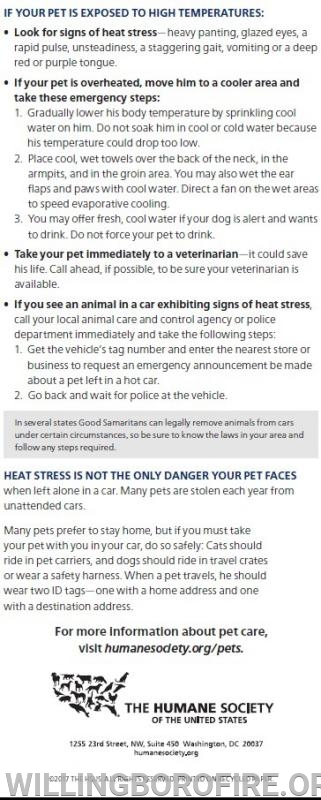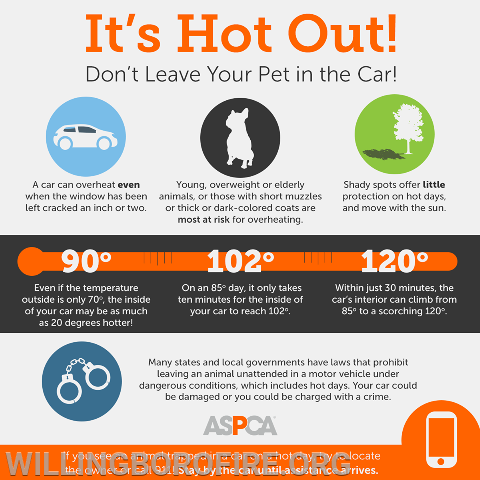| The summer months can be uncomfortable—even dangerous—for pets and people. It's difficult enough simply to cope with rising temperatures, let alone thick humidity, but things really get tough in areas that are hit with the double blow of intense heat and storm-caused power outages, sometimes with tragic results.
We can help you keep your pets safe and cool this summer. Follow our tips for helping everyone in your family stay healthy and comfortable when the heat is on (and even if the power isn't).
Practice basic summer safety
Never leave your pets in a parked car:
Not even for a minute. Not even with the car running and air conditioner on. On a warm day, temperatures inside a vehicle can rise rapidly to dangerous levels. On an 85-degree day, for example, the temperature inside a car with the windows opened slightly can reach 102 degrees within 10 minutes. After 30 minutes, the temperature will reach 120 degrees. Your pet may suffer irreversible organ damage or die. Learn how to help a pet left inside a hot car by taking action or calling for help. Local law enforcement can follow this handy guide (PDF) on how to proceed.
Watch the humidity:
"It's important to remember that it's not just the ambient temperature but also the humidity that can affect your pet," says Dr. Barry Kellogg, VMD, of the Humane Society Veterinary Medical Association. "Animals pant to evaporate moisture from their lungs, which takes heat away from their body. If the humidity is too high, they are unable to cool themselves, and their temperature will skyrocket to dangerous levels—very quickly."
Taking a dog's temperature will quickly tell you if there is a serious problem. Dogs' temperatures should not be allowed to get over 104 degrees. If your dog's temperature does, follow the instructions below for treating heat stroke.
Limit exercise on hot days:
Take care when exercising your pet. Adjust intensity and duration of exercise in accordance with the temperature. On very hot days, limit exercise to early morning or evening hours, and be especially careful with pets with white-colored ears, who are more susceptible to skin cancer, and short-nosed pets, who typically have difficulty breathing. Asphalt gets very hot and can burn your pet's paws, so walk your dog on the grass if possible. Always carry water with you to keep your dog from dehydrating.
Don't rely on a fan:
Pets respond differently to heat than humans do. (Dogs, for instance, sweat primarily through their feet.) And fans don't cool off pets as effectively as they do people.
Provide ample shade and water:
Any time your pet is outside, make sure they have protection from heat and sun and plenty of fresh, cold water. In heat waves, add ice to water when possible. Tree shade and tarps are ideal because they don't obstruct air flow. A doghouse does not provide relief from heat—in fact, it makes it worse.
Cool your pet inside and out:
Whip up a batch of quick and easy DIY peanut butter popsicles for dogs. (You can use peanut butter or another favorite food.) And always provide water, whether your pets are inside or out with you.
Keep your pet from overheating indoors or out with a cooling body wrap, vest or mat (such as the Keep Cool Mat). Soak these products in cool water, and they'll stay cool (but usually dry) for up to three days. If your dog doesn't find baths stressful, see if they enjoy a cooling soak.
Watch for signs of heatstroke:
Extreme temperatures can cause heatstroke. Some signs of heatstroke are heavy panting, glazed eyes, a rapid heartbeat, difficulty breathing, excessive thirst, lethargy, fever, dizziness, lack of coordination, profuse salivation, vomiting, a deep red or purple tongue, seizure and unconsciousness.
Animals are at particular risk for heat stroke if they are very old, very young, overweight, not conditioned to prolonged exercise, or have heart or respiratory disease. Some breeds of dogs—like boxers, pugs, shih tzus and other dogs and cats with short muzzles—will have a much harder time breathing in extreme heat.
How to treat a pet suffering from heatstroke:
Move your pet into the shade or an air-conditioned area. Apply ice packs or cold towels to their head, neck and chest or run cool (not cold) water over them. Let them drink small amounts of cool water or lick ice cubes. Take them directly to a veterinarian.
Prepare for power outages:
Before a summer storm takes out the power in your home, create a disaster plan to keep your pets safe from heat stroke and other temperature-related trouble.
Note: The information in this article was provided by The Humane Society Of The United States
|





